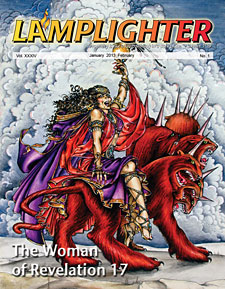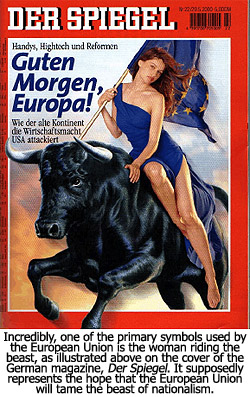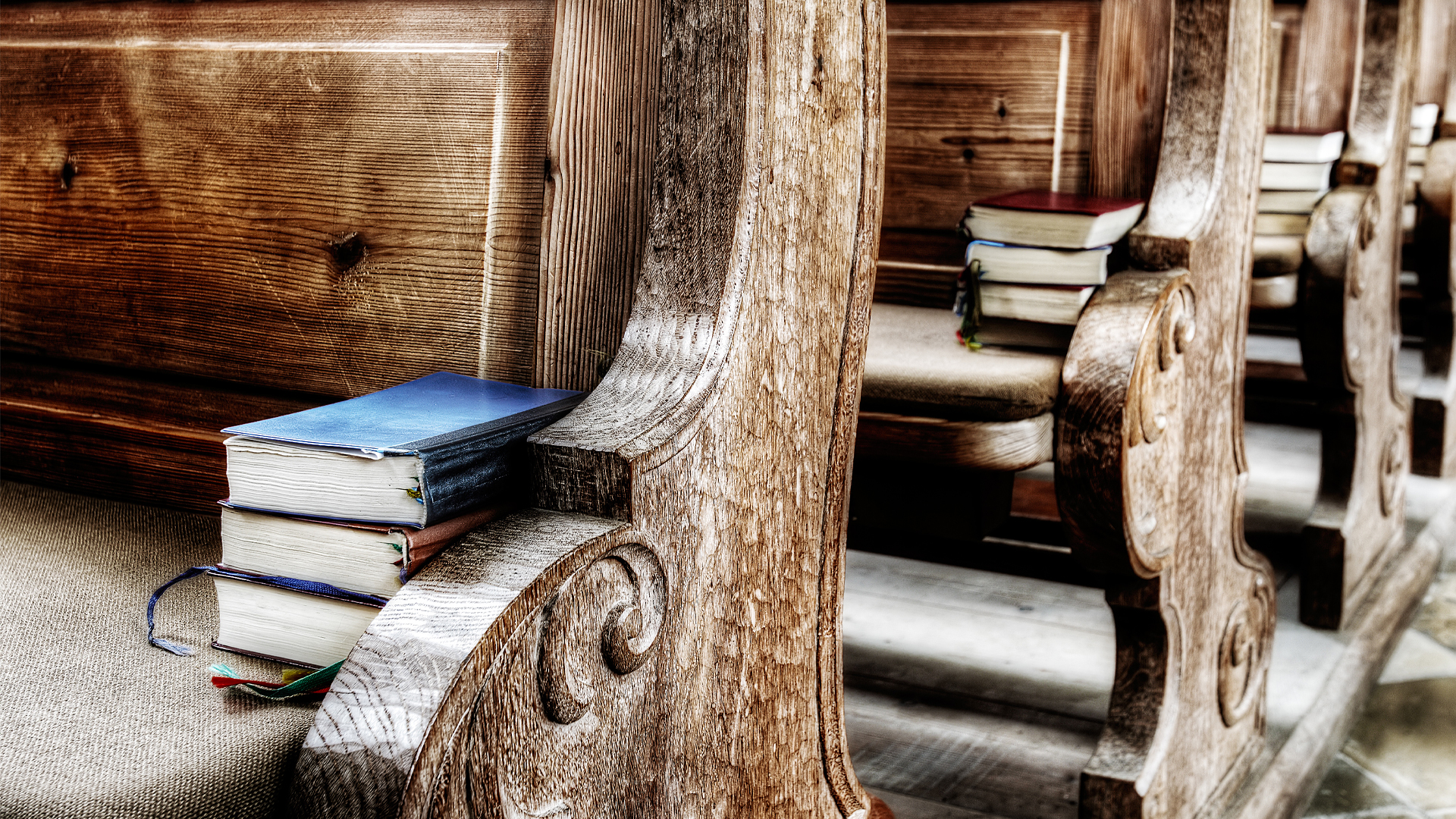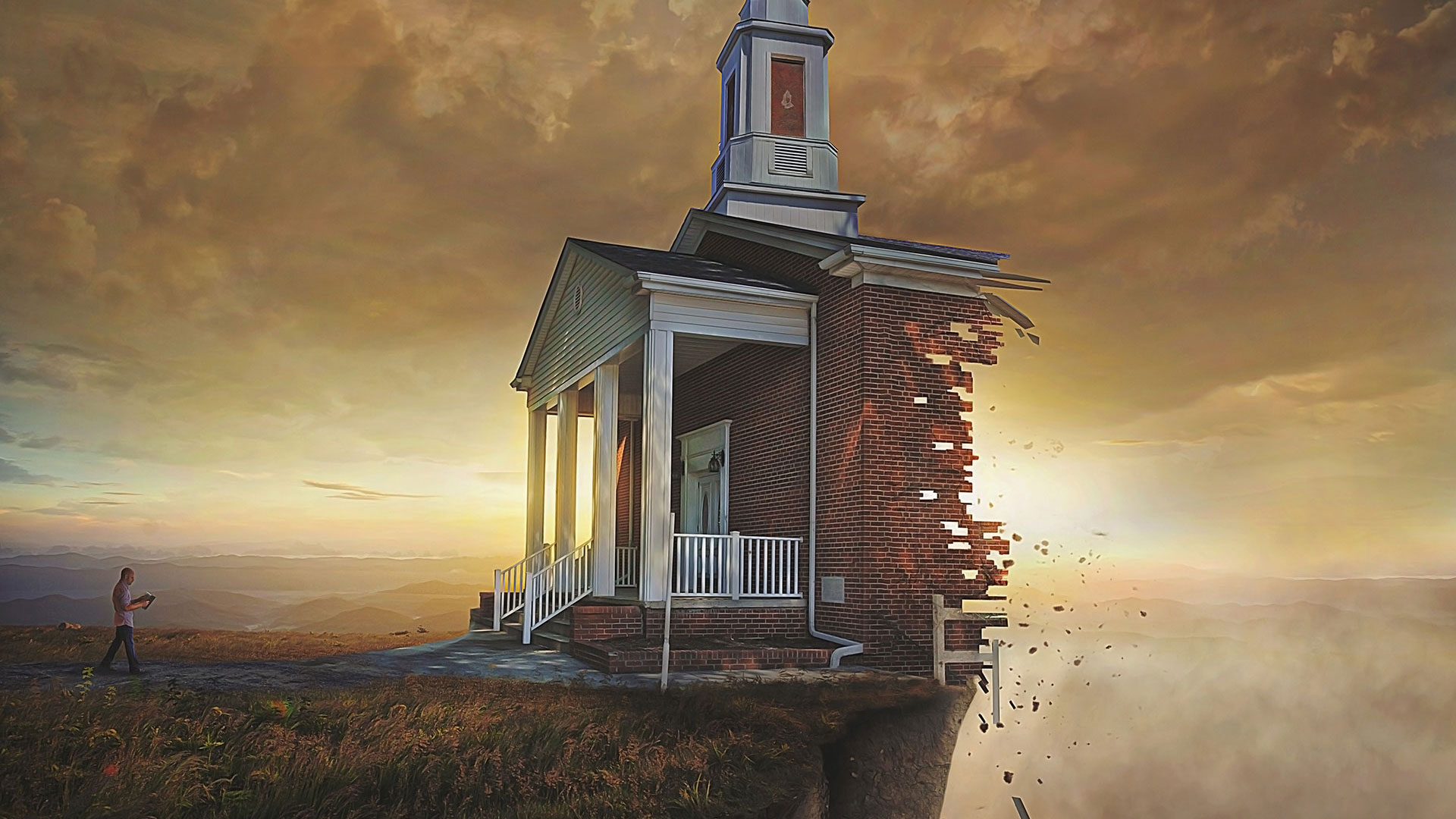Observations on the Woman of Revelation 17
Is the Harlot the Catholic Church?

I believe the evil woman pictured in Revelation 17 symbolizes the city of Rome and its corrupt spiritual system. And I believe that system will initially be an amalgamation of the world’s pagan religions, including apostate Protestants, under the leadership of the Roman Catholic Church.
In that regard, I think it is significant that in 1989 the Archbishop of the Anglican Church, Robert Runcie, called for all Christians to accept the Pope as “a common leader presiding in love.” Runcie made his appeal at an evening prayer service midway through his first official visit to the Vatican. “For the universal church, I renew the plea,” he said. “Could not all Christians come to reconsider the kind of primacy the bishop of Rome exercised with the early church, ‘a presiding in love’ for the sake of the unity of the churches in the diversity of their mission?”1
We have already been given a chilling preview of what is to come. It occurred in November 1986 in Assisi Italy when Pope John Paul II called a convocation of the leaders of twelve world religions to pray to their gods for peace. One of those who came was the Dalai Lama who is considered to be a god himself! The show was stolen by an American Indian chief who danced and whooped to his god.2
Why did the Pope feel it was necessary to bring together pagan religious leaders to pray to pagan gods? Does the Pope feel his own god is inadequate to the task? The most obvious answer is that the Pope believes all the leaders were praying to the same god.
This is one of the most popular ideas in Christendom today. It is the concept that God has revealed Himself in many different ways to different peoples. The conclusion, therefore, is that there are many roads to God. It is tolerance gone to seed. It also contradicts the Scriptures which say that God has revealed Himself in only one person, His Son, Jesus of Nazareth (Hebrews 1:1-2).
In December 2000, Pope John Paul muddied the waters further when he addressed 30,000 pilgrims in St. Peter’s Square. He told the multitude “that all who live a just life will be saved even if they do not believe in Jesus Christ and the Roman Catholic Church.”3 The Pope added, “The gospel teaches us that those who live in accordance with the Beatitudes… will enter God’s kingdom.” He concluded by observing that all that is needed for salvation is “a sincere heart.”
In short, the Pope made a liar of Jesus Christ who proclaimed, “I am the way, and the truth, and the life; no one comes to the Father, but through Me” (John 14:6). Jesus is also recorded in John 17:3 as having said, “And this is eternal life, that they may know You, the only true God, and Jesus Christ whom You have sent.”
The Church’s Destruction
Notice that the harlot is portrayed as riding on the back of the Antichrist (Revelation 17:3). I believe this symbolism indicates that the church has become a nuisance. The Antichrist has used her to help consolidate his world kingdom, but now she has become enamored with power and is trying to dominate the Antichrist and his kingdom. So, the Antichrist turns on the church and destroys her (Revelation 17:16).

At this point I believe the Antichrist will replace the Catholic Church with his new one-world religion that is headed up by the False Prophet. And, I believe this one-world religion will be Humanism carried to its ultimate conclusion — the worship of a man.
Humanism is the belief in Man. It is the foundation of all pagan religions, including pagan Christianity. The False Prophet will call on all humanity to put its trust in the Antichrist as its Lord and Savior. And since the Antichrist will be possessed by Satan (Revelation 13:2), the whole world will in reality be worshiping Satan himself.
Our Response
Considering the fact that the Catholic Church is most likely to be the cornerstone of the Apostate Church of the first half of the Tribulation, what should be our attitude toward Catholicism? Was the Reformation simply much ado about nothing? Has modern day Catholicism reformed itself sufficiently to justify our overlooking doctrinal differences in the name of Christian love and unity?
The first point I would like to make is that Catholicism is not nearly as apostate as some forms of mainline Protestant Christianity. The Catholic Church strongly affirms the virgin birth, the deity of Jesus, and the reality of the Resurrection. All three of these cornerstone truths have been rejected by mainstream liberal Protestantism in its obsessive search for what it calls “the historical Jesus.” In short, apostasy is not a Protestant versus Catholic issue. There is apostasy on both sides of the fence.
If Catholicism affirms the deity and resurrection of Jesus, then where does it fall short of Biblical standards? Where is the apostasy?
Catholic Apostasy
The apostasy of the Catholic Church is manifested first and foremost in the Church’s concept of salvation. The bottom line is that the Catholic Church has never accepted the great Biblical truth that was restored to Christendom by the Reformation — namely, that salvation is by grace through faith, and not by works (Ephesians 2:8-10).
Catholic leaders will deny this. They will affirm salvation by grace. But the fruit of their teaching and preaching testifies otherwise.4 There are millions of Catholics around the world who believe they are saved because:
they were born a Catholic, or
they received Catholic baptism as infants, or
they attend Mass twice a year, or
they go to confession regularly, or
their name is on the roll of a local parish, or
they live a good, clean moral life.
All these misguided concepts translate into one thing — belief in salvation by works. And the people who express them are spiritually lost because they have never been born again. They have no personal relationship with Jesus as their Savior and Lord.
I am not saying there are no saved Catholics. There certainly are Catholics who have discovered the Lord and have put their faith in Him. But they are the exception, and most have discovered the Lord through their own Bible study and not through the teaching of the Church.
Doctrinal Confusion
This raises the question of whether or not such true believers within Catholicism should remain there or leave. I think that question can best be answered with a series of questions:
1) Can a person grow spiritually in an atmosphere of idolatry where people are encouraged to bow before images of Mary and Saints and pray to them?
2) Can people reach their full spiritual potential in a church that denies the priesthood of all believers (I Peter 2:9), requiring its people to approach God through special priests who are not ordained in God’s Word?
3) Can people grow in the image of Jesus in a church that de-emphasizes the importance of Bible study and exalts the traditions of men over the Word of God?
4) Can people ever have any confidence of their salvation in a church that requires cleansing punishments for sin in the form of penance in this life and purgatory after death?
5) Can a person ever come to a true understanding and appreciation of the unique role and work of Christ when His mother is exalted as a co-redeemer and His sacrifice on the Cross is debased by a teaching that He must die repeatedly in the Mass?
I could go on and on, for the heresies of the Catholic Church are great in number and profound in their implications for the Christian faith.
The Veneration of Mary
Particularly appalling in modern history has been the increasing emphasis given to the worship of Mary. This gross idolatry was accentuated in 1978 by the selection of a Polish Pope, John Paul II. That’s because the adoration of Mary has long been a central focus of Polish Catholicism.

Again, Catholics will deny that they worship Mary. They argue, instead, that they simply give her the honor that she deserves. But, again, their actions speak louder than their words, and in this case, official words are sufficient to establish the point. Consider, for example, the following statement taken from an official Catholic publication:
Mary is co-redemptrix of the human race… because with Christ she ransomed mankind from the power of Satan. Jesus redeemed us with the blood of His body, Mary with the agonies of her heart… The church and the saints greet her thus: “You, O Mary, together with Jesus Christ, redeemed us… God has ordained that no grace will be granted to us except through Mary… No one will be saved or obtain mercy except through you, O Heavenly Lady… No one will enter heaven without passing through Mary as one would pass through a door… O Mary, our salvation is in your hands.”5
This is blasphemy of the worst sort. It is the ancient Babylonian mystery religion parading in new clothes, worshiping Mary as the “Queen of Heaven.”
To Leave or Not to Leave?
So, what should believing Catholics do? I have found that most try to hang in at first, attempting to have some influence on their priest or parish, hoping especially to bring the good news of a personal relationship with Jesus to their fellow Catholics. But it usually does not take long for them to realize that their efforts are not appreciated.
They must then decide whether to remain or leave. If they remain, they compromise what they believe by keeping silent, and they jeopardize their own spiritual growth. If they decide to leave, it is always a painful choice, since to depart means leaving behind dear friends. It also usually results in condemnation by family members.
What then should they do? They should do exactly what any believer should do who is caught up in any apostate religious organization, whether it be a Catholic parish or a Protestant church. They should leave!
The Bible says, “Do not be bound together with unbelievers; for what partnership… has light with darkness? Or what harmony has Christ with Belial, or what has a believer in common with an unbeliever?” (2 Corinthians 6:14-15).
Catholic Doctrine
Catholics claim to accept the Gospel, but their doctrines deny the sufficiency of the sacrifice of Jesus and the salvation of God by grace through faith.
Catholic doctrine depreciates the significance of Jesus. For example, the tremendous importance of His incarnation is diminished by the doctrine of Mary’s immaculate conception (the concept that Mary was also born without a sin nature). The all-sufficiency of the Lord’s sacrifice on the Cross is dispelled by the doctrine of Transubstantiation, which holds that He is resacrificed daily in the Mass. His current unique role as our High Priest before the throne of God is diluted by the doctrine that Mary serves as our co-redeemer and interceder.
The Jesus of Catholicism is not the Jesus of the Bible. He is a pagan god who denies us access to God the Father unless we atone for our own sins by paying penance in this life and then suffering in purgatory.
The Mary of Catholicism is also not the Mary of the Bible. The Mary of the Bible was a woman of great faith and sterling character. But she was also a sinner who needed a Savior. She acknowledged this herself when, after the birth of Jesus, she sang, “My soul exalts the Lord, and my spirit has rejoiced in God my Savior.” Yes Mary was a righteous young woman, but she needed a Savior. The Catholic Mary is just another pagan god.
Catholic Idolatry
Catholicism is steeped in idolatry. In their veneration of Mary and the Saints, Catholics commit the worst of all sins against God.
There is a myth that prevails in Christianity which says that all sins are equal. That is not true. All sins are equal only in the sense that any sin condemns us before God. But all sin is not equal in the eyes of God. There are sins that God hates more than others (Proverbs 6:16-19). That is why there are going to be degrees of punishment for the unrighteous (Isaiah 59:16-19, Luke 20:45-47 and Revelation 20:11-15).
The Bible always portrays the worst possible sin as the sin of idolatry (Isaiah 40:18-26, Isaiah 44:9-20 and Ezekiel 6:1-7). That is why the first commandment says, “You shall have no other gods before me” (Exodus 20:3), and the second says “You shall not make for yourself an idol” (Exodus 20:4).
And that is precisely why the Catholic Church, in its presentation of the Ten Commandments, always deletes the second commandment and then makes up the difference by doubling the last commandment against coveting, making of it two commands: you shall not covet your neighbor’s house, and you shall not covet his wife.6 This is blatant scriptural manipulation designed to cover up the sinful idolatry of the Church.
But God cannot be mocked (Galatians 6:7). His Word says that idolaters will be excluded from Heaven. They will be thrown into the lake of fire (Revelation 21:8).
The message of the Holy Spirit to those caught up in the spiritual darkness of Catholicism is, “Come out of Babylon!” (Revelation 18:4).
Notes
1) Sunday Advocate, Baton Rouge, LA, October 1, 1989, page 3A.
2) Time, November 10, 1986, pages 78-79.
3) Vatican City (RNS), “Pope Says Unbelievers Will Be Saved If They Live A Just Life,” December 6, 2000.
4) An excellent resource on the issue of works salvation is a booklet by Albert James Dager entitled, Six Roman Catholic Doctrines That Nullify Salvation by Grace (Media Spotlight, 1988). For a copy write to Media Spotlight at P.O. Box 290, Redmond, WA 98073.
5) CIB Bulletin, February 1991, page 1.
6) The Catholic Encyclopedia (Thomas Nelson, 1987), page 124.




